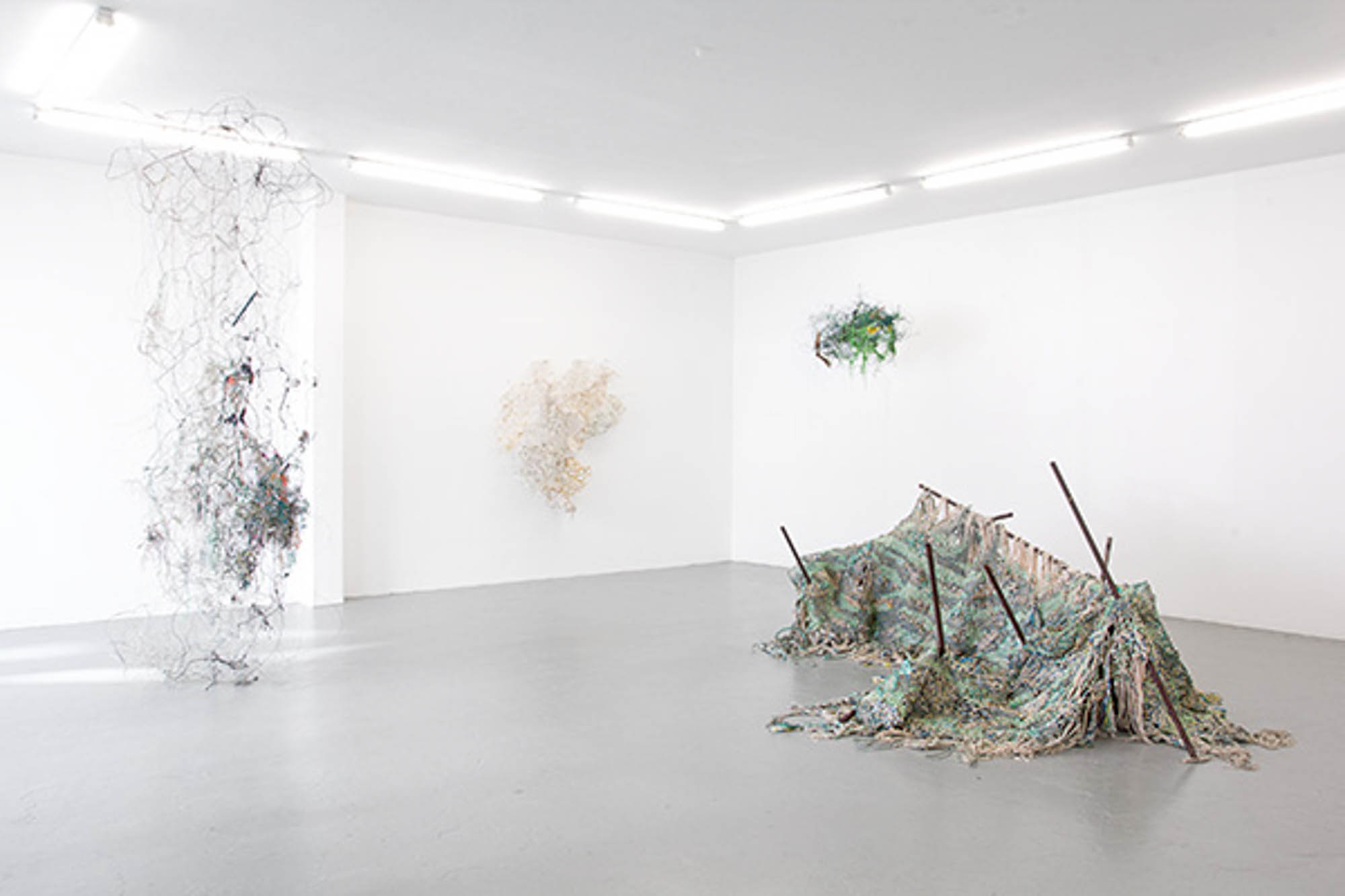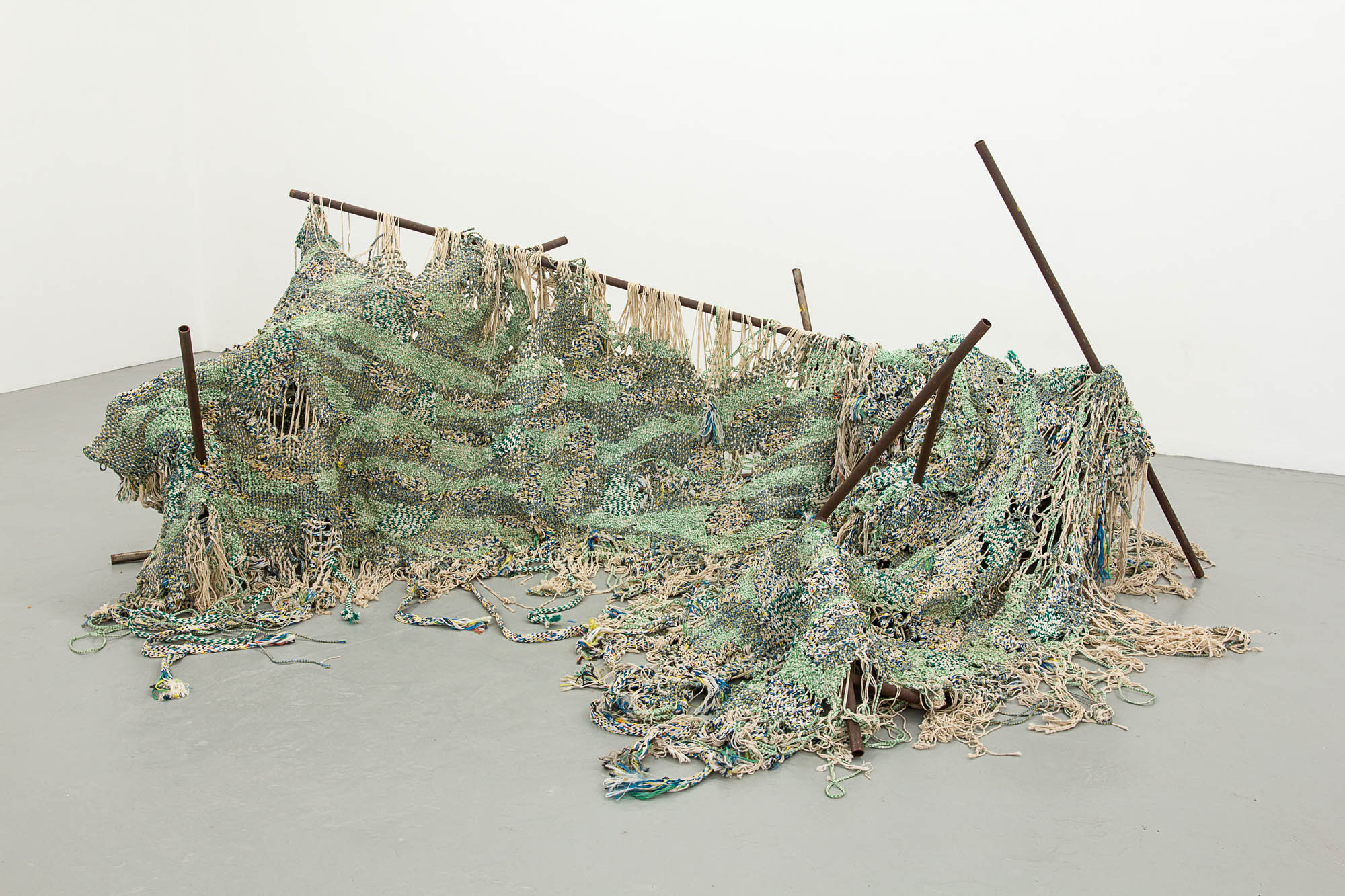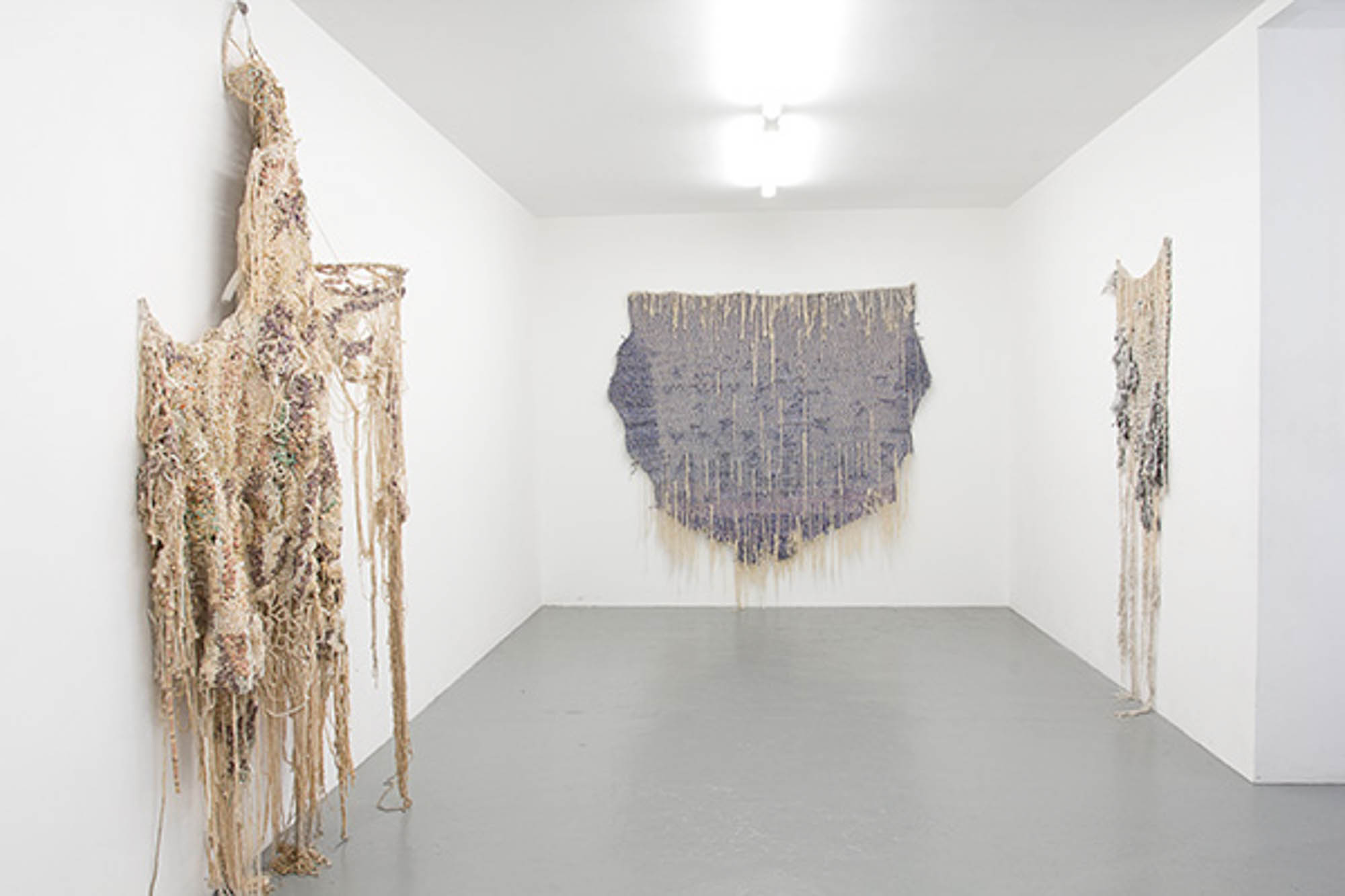












blank is pleased to present Oorskot, Igshaan Adams’ third solo with the gallery.
While in places revisiting earlier concerns, the exhibition represents an evolutionary step in Adams’ practice, both in terms of concept and form. Reflecting on his process, the artist has devised new strategies for the materialization of his ideas, evidenced in this latest body of work.
The title of the exhibition, Oorskot, is an Afrikaans word that translates as the remnants of something, or the mortal remains of a person (‘stoflike oorskot’), but can also refer to excess or surplus. Having both positive and negative associations – abundant overflow and discarded residue – ‘oorskot’ here generally refers to Adams’ use of his discarded, excess materials and other studio detritus in these new works, the careful organization of which gave rise to new forms and processes. Adams’ oeuvre is generally characterized by his use of mass-produced and waste materials (his tapestries, for example, are woven from recycled nylon rope) but in this body of work he takes it a step further, using even the remnants of remnants. This is best exemplified in Oorskot (2016), the piece that would ultimately inform the show’s title, which literally began to take form in a heap of discarded materials in a corner of Adams’ studio. Realizing that something interesting was happening, he salvaged the tangle of wire, thread and bead strings and after some careful intervention arrived at the finished artwork, a floor-to-ceiling sculptural investigation into line and texture.
Arguably, the most significant shift to take place in Adams’ new works was premised on his desire to move his tapestries off the wall, beyond the constraints of the loom and into the realm of sculpture. While exploring ways to support his freestanding tapestries, a conversation developed between Adams and sculptor Kyle Morland which quickly grew into an artistic exchange. Morland, who works primarily with mild steel, bending and contorting it into abstract compositions, began welding together framework structures for Adams to ‘inhabit’ with his weaving. The result of their collaboration – the superimposition of Adams’ organic processes onto Morland’s sculptures creates a symbiotic aesthetic; the rigidity of the steel juxtaposes the malleability of the textile, though they belong to the same entity. The impression given is that of the frameworks being ‘dressed’ by the woven material, and in the work Stoflike oorskot (2016), the weaving resembles a skin over a steel skeleton, or an unearthed burial shroud. Contributing to this imagery of decay is the surface treatment of the steel, and the dust and grime embedded in the ‘tapestry’, accumulated in the process of marrying the two elements.
Green hues dominate many of the works, the result of the artist’s gradual accumulation of green material. Culturally, the colour green is widely associated with quietude, health and vitality. In Islam, green is considered the most important colour, as it symbolises the lush vegetation of Paradise as well as the religion’s peacefulness, and it is recognised as the colour of the Prophet Muhammad’s banners and robes. An example of Adams’ prevailing use of green is the work Shahada (2016), in which the artist has experimented with a new technique using a peg loom to weave a circular shape. The title, one of the five pillars of Islam, translates as “the testimony” and declares: “there is no god but God. Muhammad is the messenger of God.”
Another work, Groen Amara (2016), takes its title from the herbal tonic for improving appetite, administered to Adams by his grandmother when he was a child. The visceral memory of the tonic’s bitterness is conveyed by the sickly colour of the green oxide dye used in the work, hinting at a more sinister tone present in the exhibition: a dark undercurrent of otherness relative to the chaos of the natural world, described by Adams as a “nightmare in which the pillars of reality have collapsed.”
While in places revisiting earlier concerns, the exhibition represents an evolutionary step in Adams’ practice, both in terms of concept and form. Reflecting on his process, the artist has devised new strategies for the materialization of his ideas, evidenced in this latest body of work.
The title of the exhibition, Oorskot, is an Afrikaans word that translates as the remnants of something, or the mortal remains of a person (‘stoflike oorskot’), but can also refer to excess or surplus. Having both positive and negative associations – abundant overflow and discarded residue – ‘oorskot’ here generally refers to Adams’ use of his discarded, excess materials and other studio detritus in these new works, the careful organization of which gave rise to new forms and processes. Adams’ oeuvre is generally characterized by his use of mass-produced and waste materials (his tapestries, for example, are woven from recycled nylon rope) but in this body of work he takes it a step further, using even the remnants of remnants. This is best exemplified in Oorskot (2016), the piece that would ultimately inform the show’s title, which literally began to take form in a heap of discarded materials in a corner of Adams’ studio. Realizing that something interesting was happening, he salvaged the tangle of wire, thread and bead strings and after some careful intervention arrived at the finished artwork, a floor-to-ceiling sculptural investigation into line and texture.
Arguably, the most significant shift to take place in Adams’ new works was premised on his desire to move his tapestries off the wall, beyond the constraints of the loom and into the realm of sculpture. While exploring ways to support his freestanding tapestries, a conversation developed between Adams and sculptor Kyle Morland which quickly grew into an artistic exchange. Morland, who works primarily with mild steel, bending and contorting it into abstract compositions, began welding together framework structures for Adams to ‘inhabit’ with his weaving. The result of their collaboration – the superimposition of Adams’ organic processes onto Morland’s sculptures creates a symbiotic aesthetic; the rigidity of the steel juxtaposes the malleability of the textile, though they belong to the same entity. The impression given is that of the frameworks being ‘dressed’ by the woven material, and in the work Stoflike oorskot (2016), the weaving resembles a skin over a steel skeleton, or an unearthed burial shroud. Contributing to this imagery of decay is the surface treatment of the steel, and the dust and grime embedded in the ‘tapestry’, accumulated in the process of marrying the two elements.
Green hues dominate many of the works, the result of the artist’s gradual accumulation of green material. Culturally, the colour green is widely associated with quietude, health and vitality. In Islam, green is considered the most important colour, as it symbolises the lush vegetation of Paradise as well as the religion’s peacefulness, and it is recognised as the colour of the Prophet Muhammad’s banners and robes. An example of Adams’ prevailing use of green is the work Shahada (2016), in which the artist has experimented with a new technique using a peg loom to weave a circular shape. The title, one of the five pillars of Islam, translates as “the testimony” and declares: “there is no god but God. Muhammad is the messenger of God.”
Another work, Groen Amara (2016), takes its title from the herbal tonic for improving appetite, administered to Adams by his grandmother when he was a child. The visceral memory of the tonic’s bitterness is conveyed by the sickly colour of the green oxide dye used in the work, hinting at a more sinister tone present in the exhibition: a dark undercurrent of otherness relative to the chaos of the natural world, described by Adams as a “nightmare in which the pillars of reality have collapsed.”